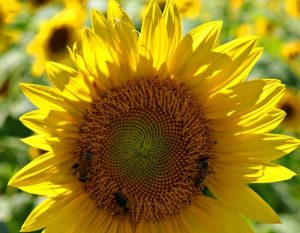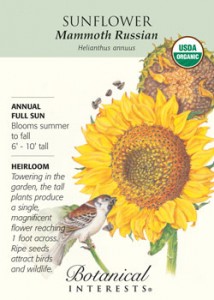The following article is from Dave’s Garden, a fabulous website full of great horticulture information and more!
The History and Uses of Sunflowers
By Melody Rose
January 28, 2017
The humble sunflower has been a part of mankind’s existence for thousands of years.

The Incas and Aztecs worshiped sunflowers (Helianthus annuus) and believed that spirits of the dead were attracted to them because they reminded those spirits of the sun.
Sunflowers are native to the Americas and have not only been a part of legends and lore, they have nourished us and healed us for centuries. Evidence shows that they have been cultivated by man for about 5,000 years, making them a rival for corn as one of the earliest crops that ancient hunter-gatherers decided to settle down and grow. In fact, there should actually be a ‘fourth sister’ counted with the sacred Three Sisters of corn, beans and squash since sunflowers contributed so much to early man’s survival. They ate the young, unopened flower buds as a vegetable and the seeds were pressed for their rich oil.
The Spanish carried them back across the Atlantic and improved upon their qualities with selective breeding to create hybrids with larger heads and better harvests.
However, it was the Russians that embraced the humble sunflower and made it what it is today. Peter the Great was so enraptured by the sunflower during a visit to western Europe in the 1700’s that he brought seeds back with him and proceeded to instruct farmers to grow them. They really didn’t catch on until it was discovered that the edible oil the seeds produced was not on the list of fats and oils that the Orthodox Church banned for Lent. That discovery was a game changer and the Russians embraced the sunflower with enthusiasm. Even today, some of the largest and most productive sunflowers are Russian bred with the most popular variety, ‘Mammoth Russian’ known by millions around the world.
Sunflowers have some other interesting properties other than an oil source. The stems, leaves and roots produce a lovely, light green to yellow natural dye while the dark colored seed hulls give us reds, purples, grays and blacks. Mordant sunflowers with vinegar.
Folk medicine utilized sunflowers as a treatment for ailments from snakebites to rheumatism.
These plants also have a unique characteristic of being able to clear toxic elements from the soil. Sunflowers planted near industrial areas draw arsenic and lead from the ground and they were even planted around the Chernobyl disaster to help remove radioactive compounds from the fields. They are also used to reclaim boggy or marshy areas because of their ability to take up great amounts of water.
Today, sunflowers are an important agricultural crop with millions of acres devoted to seed and oil production. Sunflower oil is low in polyunsaturated fats making it a heart-healthy choice for people on restricted diets. The seeds are a wholesome snack consumed by millions and of course anyone who has ever filled a bird feeder knows what wildlife thinks about them. They also make up commercial feeds for poultry and livestock, providing much needed fats and nutrients to maintain healthy flocks and herds.

Mammoth Russian Sunflower. Find seeds in The Herb Cottage seed section.
Gardeners love sunflowers for their cheerful blooms that make excellent cut flowers and there are varieties that range from knee-high midgets to back of the border monsters. Plant sunflower seeds after all chances of frost are over, in full sun. They do best in well-drained soil rich in organic matter with regular water. Some of the tallest varieties (and they can reach well over 12 feet) might need protection or staking to keep them upright when high winds threaten, but they are mostly care-free. If you want to try sunflowers as a vegetable, pick the young buds before they open and steam much like artichokes. Let the spent heads dry on the stalks to save them for winter wildlife treats.
Sunflowers are easy to grow and seeds are quite inexpensive for gardeners on a budget. Even small children and the disabled can be successful sunflower gardeners. (a sunflower was the very first plant I ever grew from seed before I ever started school) They make a great garden plant for both school kids and nursing homes. The sunflower has a rich and colorful history and from the looks of things they should be popular for another 5,000 years.
About Melody Rose

I come from a long line of Kentuckians who love the Good Earth. I love to learn about every living thing, and love to share what I’ve learned. Photography is one of my passions, and all of the images in my articles are my own, except where credited.
